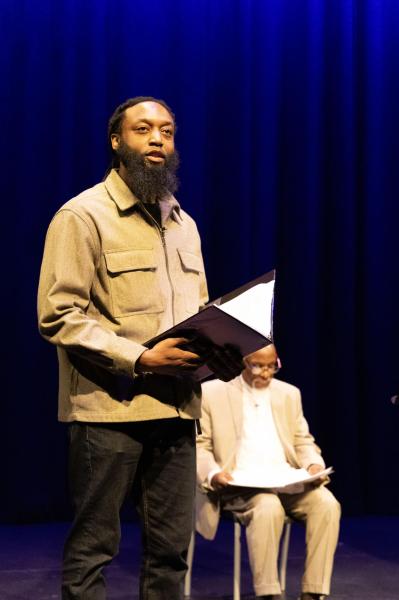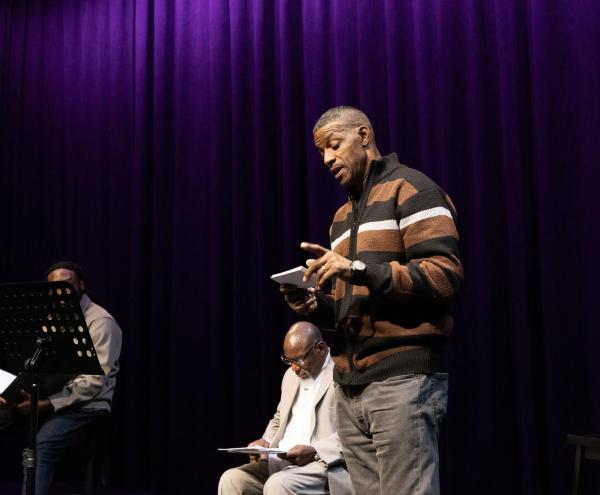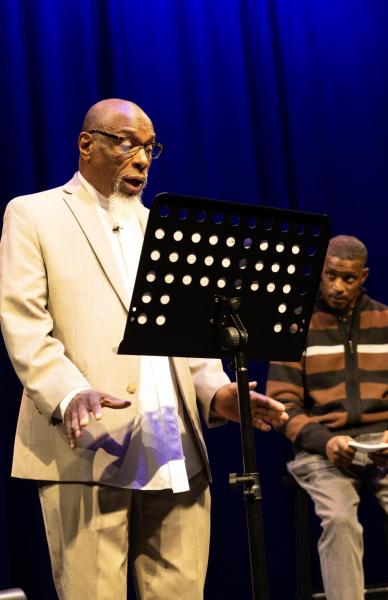When Vance Solman met Quinnipiac University students in their 300-level criminal justice course, he asked them, “Do I seem like someone that was incarcerated for 31 years?”
“And they all go, ‘Noooo,’” Solman said.
“Do I seem like someone that’s just come home, and has only been home 90 days?”
Dressed in a brown-and-black striped sweater, khakis and dress shoes, it’s hard to imagine Solman in a prison uniform – and for more than 30 years.
At 56 years old, prison has been most of Solman’s life. The same is true for Babatunde Akinjobi, Ra Hashim, Jimmy Robinson and Abdullah Shabazz, Solman’s colleagues at EMERGE Connecticut, and, for three nights from Nov. 10-12, his castmates in “As we Emerge: Monologues of the Formerly Incarcerated.”

EMERGE is a New Haven-based nonprofit that works to curb recidivism – the tendency for repeat offenses – in the state of Connecticut through dual processes. One: provide people who just got out of prison with jobs, and two: help them participate in trauma-informed counseling and programs.
Among the inmates released in Connecticut in 2019, 57% were rearrested, more than 32% were reconvicted, about 21% went on to serve a new sentence and nearly 43% returned to prison for any reason. In a state where the recidivism rate is not in favor of recently released people, theater is just one strategy community advocates are using to help reintegrate former prisoners into society.
So on Wednesday nights, when Solman, Akinjobi, Hashim, Robinson and Shabazz aren’t working their construction and landscaping jobs — which secure them a liveable wage and job security — they come to the Quinnipiac Theater Arts Building to meet with CJ-300 students and work on something else: art.
The course — taught by Steve McGuinn, associate professor of criminal justice, and assisted by theater professors Rose Bochansky and Abigail Copeland — and its resulting performances focus on the “What’s next?” of post-incarceration life.
It’s the second time EMERGE members and Quinnipiac students have come together to co-write, produce and perform monologues, but no one has had the experience since 2018.
The process begins with an interview.
Students come up with questions for the former inmates, perhaps asking them, “What was your childhood like?” and “How did you feel leaving prison after decades?”
From there, the students comb through transcripts and pick out the parts of the five men’s stories that make it into the script.
With a two-hour runtime, the script covers a lot of ground: abusive childhoods, drug addiction, crime, imprisonment, death, an inequitable legal system and institutionalized racism. But it also tells the stories of hope, breaking free, family and making the most out of an unimaginable situation.
The creative steps included a lot of painful reliving.
“Reliving certain events again, certain things, you kind of put away, not for good or bad, you just be done with it, and then when you’re going back down this road … all the things coming back, now you’re processing again, and then you’re like, ‘Maybe that’s why I was acting like that,’ especially when I was younger,” Hashim said. “Not really knowing why I was moving where I was moving. But being older now, you go, ‘Oh, OK.’”

The performances as a whole are not really about what crimes the cast members did or did not commit, though they don’t shy away from their pasts. Shabazz speaks openly about killing a man in 1994. Robinson is honest, too: he committed murder and was sentenced to death by the state of Louisiana. If that sentence hadn’t been commuted, he wouldn’t be here, delivering this monologue.
“There’s a lot of guys that don’t try to get better or do anything better in their lives, and they became bitter, angry, but you can’t be angry for something that you caused,” Solman said. “You can’t be angry. What are you going to be angry for? It’s just … you made a bad decision.”
All of the cast members own up to their mistakes, but their monologues are more about the root causes. In the words of Shabazz, many incarcerated people “never had a childhood.”
“Most of the time, you start when (incarcerated people) go into prison and you hear about just that section of their life,” said Sophia Ferrara, a junior criminal justice major in the EMERGE course. “But to hear that whole story, and to see that full context of them as a human being, rather than just seeing the short part of them as being an inmate, or as a criminal, to be able to do that and to help be a part of telling their whole story, it was really incredible.”
Next, the students — with the assistance of the theater faculty — work with the cast to help them hone their stage skills and memorize their lines.
“Even from the first rehearsal that we went to, then to the second rehearsal, it was really impressive to see the way that they all were becoming more and more comfortable with the script,” Ferrara said. “So to see them become comfortable again, telling these stories, you can start to hear their character coming out again and their personality.”
Each man found ways to deal with the claustrophobic containment of prison.

Solman mentored (what he calls) his “jail sons” — five or six guys who needed a little parental guidance. Shabazz wrote three books of poetry, which he calls “P.P.P.” — “Poems from a Prison Poet.” Akinjobi — an artist as a young boy — drew pictures to send to his kids. Hashim read about Black activists and trailblazers, from Angela Davis to Harriet Tubman.
Now, Hashim is proud to call himself an activist in his own right. He was a part of the group of former inmates who testified before Connecticut lawmakers urging them to shutdown Northern Correctional Institution in Somers, based on allegations of poor treatment behind the walls of the dated institution. Gov. Lamont announced the shuttering of the supermax prison in June 2021.
“Being in the cell, studying Angela and other activists and just being motivated to do that … then coming home and doing it, that’s one of my proudest moments,” Hashim said. “Something I get to share with my family, share with my son. I’m not just talking about it, I’m doing it.”
The shows on Nov. 10, 11 and 12 were sold out, but a moment that elicited a chuckle from even the small crowd at “Emerge”’s open dress rehearsal on Nov. 9 was when the cast took turns throwing out anecdotes about the strangeness they experienced when first getting out of prison.
They laughed about the scary experience of walking into a grocery store or a mall for the first time in years. Too loud, too fast, too much going on.
They missed so much — not only births and funerals in their own families, but the world changing outside of prison walls.

After decades inside, Shabazz’s very first introduction to an iPhone went about as well as could be expected. When an outreach worker told him to swipe the screen to pick up a call — TWACK! — he delivered a powerful backhand smack to the smartphone.
There’s also the responsibilities of the “real world.”
“In prison, I didn’t have to worry about paying rent,” Robinson joked in his monologue.
As of July 2022, there were 10,000 people incarcerated in the Connecticut prison system, and it is well reported that justice doesn’t apply equally to each of them. In 2020, Black people made up 44% of the state’s prison population, but only 13% of the overall state population. Similarly, Hispanic and Latino people made up only 18% of Connecticut’s population, but constituted 27% of people in its prisons.
“You can just tell by their stories, how (the system) doesn’t really favor Black Americans as much,” said Savaira Baig, a sophomore criminal justice major in the EMERGE class.
EMERGE is focused on changing outcomes — and it has. The organization reports a recidivism rate of 12%, a decrease compared to former inmates who are not involved in the reentry program. In addition, over 80% of EMERGE members are still employed a year after they enroll in the program, with many moving on to full-time work.
But the program, and the monologues, are also about dignity. They are an outlet, a place to work and an understanding that the formerly incarcerated are more than an inmate number.
“Now, I’m home, and my vulnerability is on display, but I don’t mind,” Akinjobi said. “I embrace it, because I want (my family) to see that I’m still vulnerable, that I’m still human.”
This post was originally published on this site be sure to check out more of their content.






